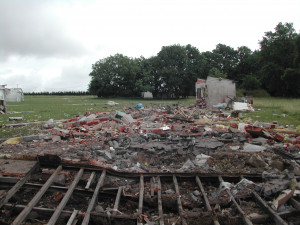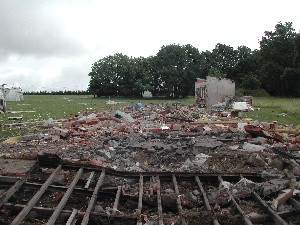Around 11:20 am, an explosion ripped through a building of a facility used to manufacture fireworks. Extended by an awning, the building in question contained 2 parts separated by a reinforced wall. According to the facility manager, 2 employees beneath the awning began assembling 60-mm fireworks shells (powder + stars in a plastic shell) in order to subsequently produce several candles. These stored materials, following assembly in the first part of the building, were considered as belonging to Division 1.3 (normally not leading to detonation). The building’s second part was where the filling step took place on shafts (composed of an alternation of shells and active material used for their ejection), which were then transported to another building. According to witness testimony, the accident occurred in two stages: an initial explosion followed shortly thereafter with a second, more violent explosion accompanied by thick white smoke. Both employees working in this building at the shell filling / assembly stations were killed; their bodies would be found at distances of 20 m and 25 m from their station. Two other employees were slightly injured (hearing disorders) in nearby buildings. The extent of property damage attests to the violence of this explosion; 14 of the facility’s 27 pyrotechnic buildings were either totally or partially destroyed, 9 others damaged, and 5 others had to be razed. The building where detonation struck was totally obliterated, with a crater 3 m x 1.5 m x 0.5 m deep visible in the concrete foundation plate. A 50-kg cart was projected a distance of 150 m, chunks of the wall littered over a 50-m radius. The blockhouses storing the explosive substances were slightly penetrated. No domino effect was observed. Only a few impacts were noticeable outside the facility, with the exception of the nearest residence (broken windows). 2 employees had to be made redundant due to the ensuing shutdown. A judicial and administrative investigation was conducted in order to determine the causes. Upon proposal of the inspection authorities, the Prefect issued an emergency order requesting: shutdown of the site’s manufacturing activities, disposal of finished products, restoration of the premises in order to ensure the storage of pyrotechnic substances in accordance with their certification stamping, and the separation of storage spaces between end use and intermediate products. Given the effects observed, this pyrotechnic material wound up detonating; the TNT equivalent was estimated at 15-30 kg. While the origin of the fire outbreak remained unknown, it could have been exacerbated by configurations prohibited inside the building (door separating the two premises left open with a relay effect due to the handling cart?). The risk introduced by products typically stored on these premises had been poorly evaluated (with the risk of detonation being overlooked, despite the presence of “bulk” storage within a confined space).
Download the detailed report in .pdf format (1.1 Mb)






